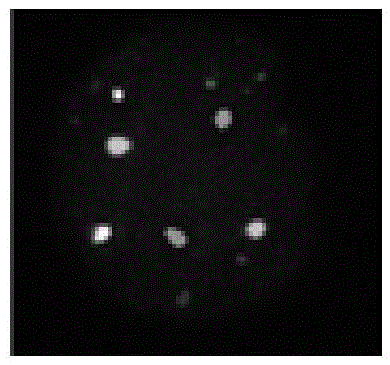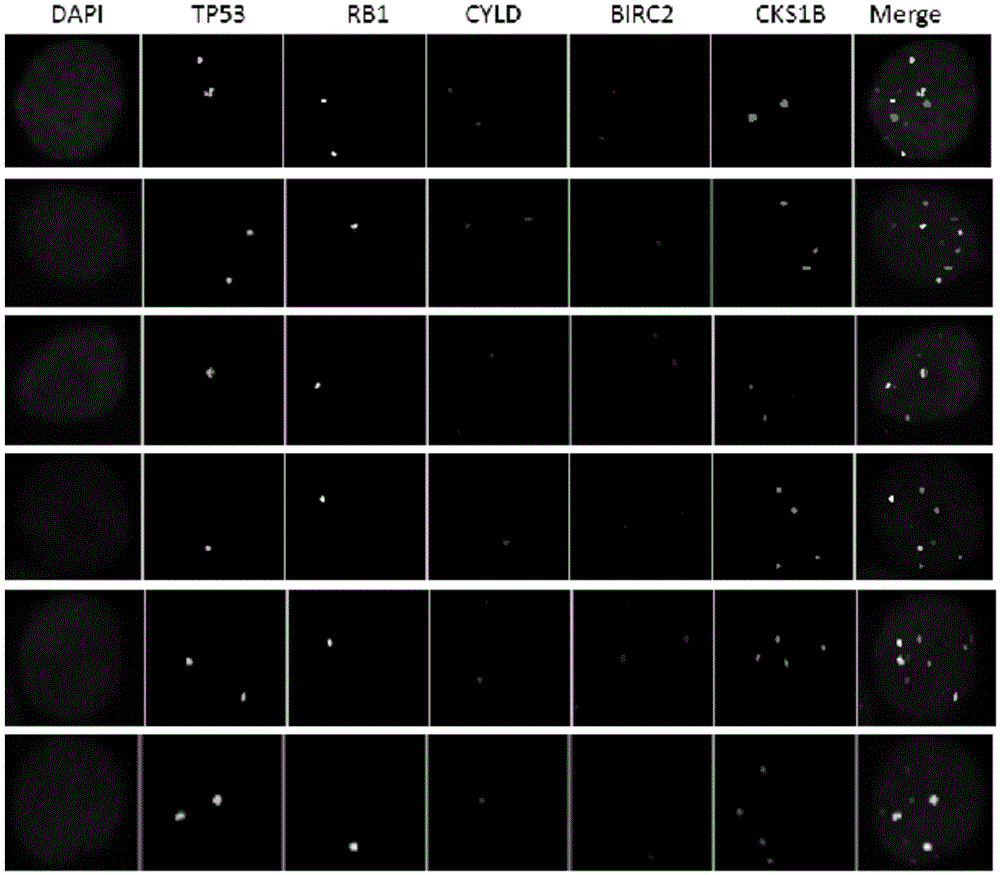Gene probe composition and kit for detecting clone evolution of multiple myeloma
A technology of multiple myeloma and gene probes, applied in the direction of recombinant DNA technology, microbial measurement/inspection, biochemical equipment and methods, etc., can solve the problem of not being able to reflect the pathological process, and achieve the goal of improving detection ability and efficiency Effect
- Summary
- Abstract
- Description
- Claims
- Application Information
AI Technical Summary
Problems solved by technology
Method used
Image
Examples
Embodiment 1
[0070] Embodiment 1: The preparation method of TP53 gene probe comprises the following steps:
[0071] 1. Primer design and clone screening: The TP53 gene is located at 17P13.1, the short arm of human chromosome 17. Search for all clones containing the TP53 gene in UCSCgenomebrowser, NCBICloneRegistry, and EnsemblGenomeBrowser databases, and use polymerase chain reaction to screen out the optimal clone containing the gene. The serial number is RP11-89D11 (as shown in Table 1).
[0072] 2. Cloning culture and identification: purchase clone RP11-89D11 (Invitrogen, USA), take 8 microliters of clone bacteria solution and add it to 5 milliliters of LB liquid medium containing chloramphenicol resistance, shake and activate for 12 hours at 37°C ; Then add all the bacterial liquid to 450 ml of LB liquid medium containing chloramphenicol resistance, and collect the bacterial liquid after shaking and culturing at 37°C for 12 hours. The upstream primer 5'-TGACACGCTTCCCTGGATTG-3' and the ...
Embodiment 2
[0101] Embodiment 2: the preparation method of TP53, Rb1, CKS1B, CYLD, BIRC2 gene probe composition, comprises the following steps
[0102] 1. Primer design and clone screening:
[0103]By searching UCSCgenomebrowser, NCBICloneRegistry, EnsemblGenomeBrowser and other databases, all clones containing TP53, Rb1, CKS1B, CYLD, BIRC2 genes were screened out by polymerase chain reaction, and the numbers were: RP11-89D11, RP11-305D15 , RP11-307C12, RP11-327F22, RP11-864G5 (as shown in Table 1).
[0104] 2. Cloning culture and identification: purchase the clone according to the clone number (Invitrogen, USA), take 8 microliters of the clone bacteria solution and add it to 5 milliliters of chloramphenicol-resistant LB liquid medium, shake and activate at 37°C for 12 hours Then all the bacterial liquid was added to 450 ml of LB liquid medium containing chloramphenicol resistance, and the bacterial liquid was collected after shaking and culturing at 37°C for 12 hours, and 5 target genes...
Embodiment 3
[0143] Embodiment 3: A kind of test kit (50 people) of detection multiple myeloma clonal evolution, composition is as follows:
[0144]
[0145] Among them, the fluorescent labeling probe group hybridization mixture includes TP53 gene probe, Rb1 gene probe, CKS1B gene probe, CYLD gene probe, BIRC2 gene probe, and the concentration of TP53 gene probe is: 4ng / μL, Rb1 gene probe Probe concentration: 4ng / μL, CKS1B gene probe concentration: 4ng / μL, CYLD gene probe concentration: 4ng / μL, BIRC2 gene probe concentration: 4ng / μL. The components of the hybridization mixture include 50% deionized formamide, 2×SSC and 0.1 g / ml dextran sulfate.
PUM
 Login to View More
Login to View More Abstract
Description
Claims
Application Information
 Login to View More
Login to View More - R&D
- Intellectual Property
- Life Sciences
- Materials
- Tech Scout
- Unparalleled Data Quality
- Higher Quality Content
- 60% Fewer Hallucinations
Browse by: Latest US Patents, China's latest patents, Technical Efficacy Thesaurus, Application Domain, Technology Topic, Popular Technical Reports.
© 2025 PatSnap. All rights reserved.Legal|Privacy policy|Modern Slavery Act Transparency Statement|Sitemap|About US| Contact US: help@patsnap.com



